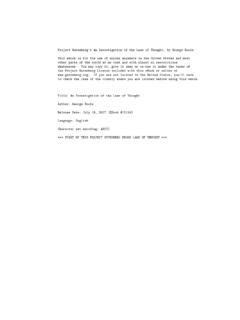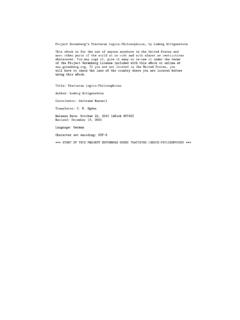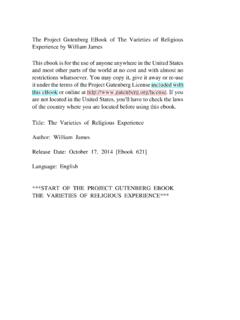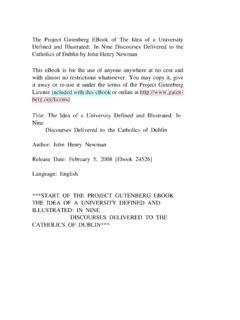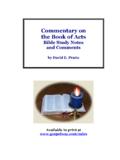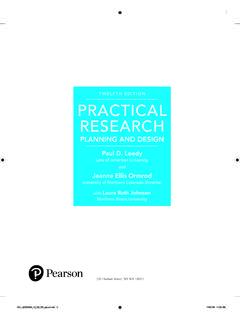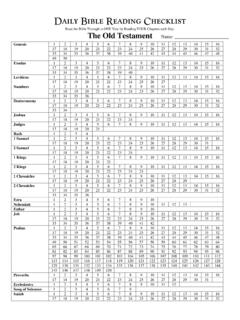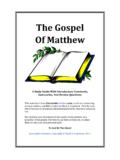Transcription of Zen Experience P - Project Gutenberg
1 ======================================== ======================This work is licensed under a Creative Commons Attribution Unported License, THE ZEN EXPERIENCETHE ZEN EXPERIENCETHE ZEN EXPERIENCETHE ZEN Experience Library Journal called it, The best history of Zen ever written. The truth of Zen has always resided in individual Experience rather than in theoretical writings. To give the modern reader access to understanding of this truth, THE ZEN Experience illumines Zen as it was created and shaped by the personalities, perceptions, and actions of its masters over the centuries. Beginning with the twin roots of Zen in Indian Buddhism and Chinese Taoism, we follow it through its initial flowering in China under the First Patriarch Bodhidharma; its division into schools of gradual and sudden enlightenment under Shen-hsui and Shen-hui; the ushering in of its golden age by Hui-neng; the development of shock enlightenment by Ma-tsu; its poetic greatness in the person of Han-shan; the perfection of the use of the koan by Ta-hui; the migration of Zen to Japan and its extraordinary growth there under a succession of towering Japanese spiritual leaders.
2 Rich in historical background, vivid in revealing anecdote and memorable quotation, this long-needed work succeeds admirably in taking Zen from the library shelves and restoring its living, human form. BOOKS BY THOMAS HOOVERBOOKS BY THOMAS HOOVERBOOKS BY THOMAS HOOVERBOOKS BY THOMAS HOOVER NonfictionNonfictionNonfictionNonfiction Zen Culture The Zen Experience FictionFictionFictionFiction The Moghul Caribbee Wall Street Samurai (The Samurai Strategy) Project Daedalus Project Cyclops Life Blood Syndrome All free as e-books at THE THE THE THE ZEN ZEN ZEN ZEN EXPERIENCEEXPERIENCEEXPERIENCEEXPERIENCE Thomas Hoover Thomas Hoover Thomas Hoover Thomas Hoover SIGNET, SIGNET CLASSICS, MENTOR, PLUME, MERIDIAN AND NAL BOOKS are published in the United States by The New American Library, Inc.
3 , 1633 Broadway, New York, New York 10019. First Printing, March, 1980 Copyright 1980 by Thomas Hoover Reissued by arrangement with Penguin Group New York, New York. Library of Congress Cataloging in Publication Data Bibliography Zen Buddhism History. Priests, Zen Biography. ISBN 0-452-25228-8 Author: Thomas Hoover Title: The Zen Experience Zen History, Buddhism, Zen Buddhism, Zen History, Seng-Chao, Tao-sheng, Lao Tzu, Chuang Tzu, Kuo Hsiang, Nagarjuna, Seng-chao, Tao-Sheng, Bodhidharma, Hui ko, Seng-Ts an, Tao-hsin, Fa-jung, Hung-jen, Shen-hsiu, Hui-neng, Ma-tsu, Huai-hai, Nan chuan, Chao-Chou, P ang, Han-shan, Huang-po, Lin-Chi, Rinzai, Soto, Tung-shan, Ts ao-shan, Kuei-shan, Yun-men, Fa-yen, Ta-hui, Eisai, Dogen, Hakuin PERMISSIONSPERMISSIONSPERMISSIONSPERMISS IONS Selections from Zen and Zen Classics, Vols.
4 I and II, by R. H. Blyth (Tokyo: The Hokuseido Press, copyright 1960, 1964 by R. H. Blyth, copyright 1978 by Frederick Franck), reprinted by permission of Joan Daves. Selections from Cold Mountain by Han-shan, Burton Watson, trans. (New York: Columbia University Press, 1970), reprinted by permission of publisher. Selections from The Recorded Sayings of Layman Pang, ruth Fuller Sasaki et al., trans. (New York: John Weatherhill), reprinted by permission of publisher. Selections from Anthology of Chinese Literature, Cyril Birch, ed., Gary Snyder, trans. (New York: Grove Press, copyright 1965 by Grove Press), reprinted by permission of publisher. Selections from Tao: A New Way of Thinking by Chang Chung-yuan, (New York: Harper & Row, Perennial Library, copyright 1975 by Chang Chung-yuan), reprinted by permission of publisher.
5 Selection from A History of Zen Buddhism by Heinrich S. J. Dumoulin, Paul Peachey, trans. (New York: Pantheon Books, 1962), reprinted by permission of publisher. Selection by Ikkyu from Some Japanese Portraits by Donald Keene (Tokyo: Kodansha International, 1979), reprinted by permission of author. Selections from Essays in Zen Buddhism by D. T. Suzuki (New York: Grove Press), reprinted by permission of publisher. Selection from The Sutra of Hui-neng, Price and Wong, trans. (Boulder: Shambala Publications), reprinted by permission of publisher. Selections from The Platform Sutra of the Sixth Patriarch, Philip Yamplosky, trans. (New York: Columbia University Press), reprinted by permission of publisher. Selections from The Zen Master Hakuin by Philip Yamplosky (New York: Columbia University Press, 1971), reprinted by permission of publisher.
6 Selections from The Golden Age of Zen by John C. H. Wu (Taipei, Taiwan: Hwakang Book Store), reprinted by permission of author. Selections from The Zen Teaching of the Hui Hai on Sudden Illumination by John Blofeld (New York: Samuel Weiser, 1972), reprinjted by permission of publisher. Selections from Zen Master Dogen by Yoho Yukoi (New York: John Weatherhill), reprinted by permission of publisher. Selections from Original Teachings of Ch'an Buddhism by Chang Chung-yuan (New York: Vintage, 1969), reprinted by permission of publisher. Selections from Swampland Flowers by Christopher Cleary (New York: Grove Press, copyright 1977 by Christopher Cleary), reprinted by permission of publisher. Selections from The Zen Teaching of Huang Po on the Transmission of Mind by John Blofeld (New York: Grove Press, copyright 1958 by John Blofeld), reprinted by permission of publisher.
7 Selections from Zen-Man Ikkyu, a dissertation by John Sanford, University of North Carolina, Chapel Hill, reprinted by permission of author. Selections from Zen is Eternal Life by Roshi Jiyu-Kennett (Dharma Publishing, copyright 1976 by Roshi Jiyu-Kennett), reprinted by permission of author). ACKNOWLEDGMENTSACKNOWLEDGMENTSACKNOWLEDG MENTSACKNOWLEDGMENTS Heartfelt thanks go to Dr. Philip Yampolsky of Columbia University, who reviewed the manuscript in draft and clarified many points of fact and interpretation. I also am indebted to the works of a number of Zen interpreters for the West, including D. T. Suzuki, John Blofeld, Chang Chung-yuan, and Charles Luk. In cases where this finger pointing at the moon mistakenly aims astray, I alone am responsible.
8 CONTENTSCONTENTSCONTENTSCONTENTS Preface to ZenPreface to ZenPreface to ZenPreface to Zen Taoism: The Way to Zen Lao Tzu Chuang Tzu Kuo Hsiang: A Neo-Taoist The Seven Sages of the Bamboo Grove The Buddhist Roots of Zen The Buddha Nagarjuna Kumarajiva Seng-chao Tao-sheng The Synthesis PART I. THE EARLY MASTERSPART I. THE EARLY MASTERSPART I. THE EARLY MASTERSPART I. THE EARLY MASTERS 1. Bodhidharma: First Patriarch of Zen 2. Hui-k'o: Second Patriarch of Zen 3. Seng-Ts'an, Tao-hsin, Fa-jung, and Hung-jen: Four Early Masters 4. Shen-hsiu and Shen-hui: "Gradual" and "Sudden" Masters 5. Hui-neng: Sixth Patriarch and Father of Modern Zen PART II. THE GOLDEN AGE OF ZENPART II. THE GOLDEN AGE OF ZENPART II. THE GOLDEN AGE OF ZENPART II. THE GOLDEN AGE OF ZEN 6.
9 Ma-tsu: Originator of "Shock" Enlightenment 7. Huai-hai: Father of Monastic Ch'an 8. Nan-ch'uan and Chao-chou: Masters of the Irrational 9. P'ang and Han-shan: Layman and Poet 10. Huang-po: Master of the Universal Mind PART III. SECTARIANISM AND THE KOANPART III. SECTARIANISM AND THE KOANPART III. SECTARIANISM AND THE KOANPART III. SECTARIANISM AND THE KOAN 11. Lin-chi: Founder of Rinzai Zen 12. Tung-shan and Ts'ao-shan: Founders of Soto Zen 13. Kuei-shan, Yun-men, and Fa-yen: Three Minor Houses 14. Ta-hui: Master of the Koan PART IV. ZEN IN JAPANPART IV. ZEN IN JAPANPART IV. ZEN IN JAPANPART IV. ZEN IN JAPAN 15. Eisai: The First Japanese Master 16. Dogen: Father of Japanese Soto Zen 17. Ikkyu: Zen Eccentric 18. Hakuin: Japanese Master of the Koan 19.
10 Reflections NotesNotesNotesNotes BibliographyBibliographyBibliographyBibl iography THE ZEN EXPERIENCETHE ZEN EXPERIENCETHE ZEN EXPERIENCETHE ZEN Experience The sole aim of Zen is to enable one to understand, realize, and perfect his own mind. Garma C. C. Chang PREFACE TO ZENPREFACE TO ZENPREFACE TO ZENPREFACE TO ZEN Lao Tzu, Buddha, Confucius Some call it "seeing," some call it "knowing," and some describe it in religious terms. Whatever the name, it is our reach for a new level of consciousness. Of the many forms this search has taken, perhaps the most intriguing is Zen. Growing out of the wisdom of China, India, and Japan, Zen became a powerful movement to explore the lesser-known reaches of the human mind. Today Zen has come westward, where we are rediscovering modern significance in its ancient insights.
